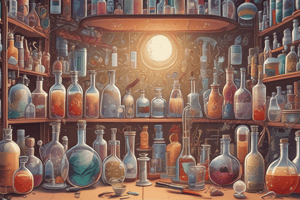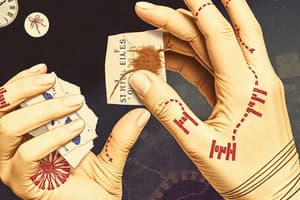Podcast
Questions and Answers
What is the recommended container for urine specimens?
What is the recommended container for urine specimens?
- Agar plate
- Clean, leakproof container (correct)
- Sterile container
- Swab transport system
All specimens for microbiology cultures can be collected in non-sterile containers.
All specimens for microbiology cultures can be collected in non-sterile containers.
False (B)
Why is India ink used in microbiology?
Why is India ink used in microbiology?
To stain Cryptococcus neoformans.
Specimens for microbiology cultures should be collected in __________ containers.
Specimens for microbiology cultures should be collected in __________ containers.
What should be used if the eardrum is intact during ear specimen collection?
What should be used if the eardrum is intact during ear specimen collection?
What is the purpose of using separate swabs for eye conjunctiva sampling?
What is the purpose of using separate swabs for eye conjunctiva sampling?
The inner ear specimen collection method involves cleaning the ear canal with _____ and aspirating fluid.
The inner ear specimen collection method involves cleaning the ear canal with _____ and aspirating fluid.
Cotton tips are the preferred choice for specimen collection.
Cotton tips are the preferred choice for specimen collection.
What is a suitable alternative to cotton tips for specimen collection?
What is a suitable alternative to cotton tips for specimen collection?
Flashcards are hidden until you start studying
Study Notes
Specimen Collection
- All microbiology culture specimens must be collected in sterile containers to prevent cross-contamination, except for stool specimens.
- Ear specimens:
- Inner ear: Clean with mild soap and aspirate fluids; a sterile, screw-cap tube or anaerobic transport system is used.
- Outer ear: Remove debris with a saline-moistened swab transport system.
- Eye specimens:
- Conjunctiva: Sample from both eyes using separate swabs moistened with sterile saline.
- Corneal scrapings require a local anesthetic and scraping with a sterile spatula, then inoculating directly to agar.
- Fecal specimens should be collected directly into clean leakproof containers, avoiding urine contamination.
Transport Media and Specimen Handling
- Modified swab tips can use Dacron, rayon, or calcium alginate as an alternative to cotton, which is toxic to some microorganisms.
- Specific transport systems are in place for various specimen types, ensuring the integrity of the sample during transportation.
Common Specimens in Microbiology
- Typical samples include blood cultures, CSF (cerebrospinal fluid), fungal scrapings, and other body fluid collections.
- Blood culture collection involves transferring blood to culture media to detect pathogens.
Preservatives and Anticoagulants
- Special attention must be given to the choice of anticoagulants and preservatives to maintain specimen viability and integrity for testing.
Specimen Prioritization and Rejection
- Timing and prioritization for specimen processing are crucial to enhance accuracy in diagnosis.
- Specific criteria are set to determine the acceptance or rejection of specimens based on handling and transportation conditions.
Sputum Criteria
- Sputum specimens must meet specific criteria to ensure they are suitable for microbiological analysis.
Laboratory Techniques
- India ink is used to stain Cryptococcus neoformans, a fungal pathogen that causes meningitis, highlighting important diagnostic techniques in microbiological analysis.
Studying That Suits You
Use AI to generate personalized quizzes and flashcards to suit your learning preferences.





